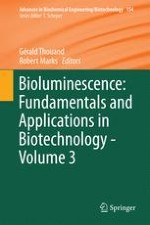2016 | OriginalPaper | Buchkapitel
Let There Be Light! Bioluminescent Imaging to Study Bacterial Pathogenesis in Live Animals and Plants
verfasst von : Issmat I. Kassem, Gary A. Splitter, Sally Miller, Gireesh Rajashekara
Erschienen in: Bioluminescence: Fundamentals and Applications in Biotechnology - Volume 3
Aktivieren Sie unsere intelligente Suche, um passende Fachinhalte oder Patente zu finden.
Wählen Sie Textabschnitte aus um mit Künstlicher Intelligenz passenden Patente zu finden. powered by
Markieren Sie Textabschnitte, um KI-gestützt weitere passende Inhalte zu finden. powered by
